Great stellated dodecahedron
Template:Reg star polyhedron stat table File:Great stellated dodecahedron.stl In geometry, the great stellated dodecahedron is a Kepler–Poinsot polyhedron, with Schläfli symbol {5⁄2,3}. It is one of four nonconvex regular polyhedra.
It is composed of 12 intersecting pentagrammic faces, with three pentagrams meeting at each vertex.
It shares its vertex arrangement, although not its vertex figure or vertex configuration, with the regular dodecahedron, as well as being a stellation of a (smaller) dodecahedron. It is the only dodecahedral stellation with this property, apart from the dodecahedron itself. Its dual, the great icosahedron, is related in a similar fashion to the icosahedron.
Shaving the triangular pyramids off results in an icosahedron.
If the pentagrammic faces are broken into triangles, it is topologically related to the triakis icosahedron, with the same face connectivity, but much taller isosceles triangle faces. If the triangles are instead made to invert themselves and excavate the central icosahedron, the result is a great dodecahedron.
The great stellated dodecahedron can be constructed analogously to the pentagram, its two-dimensional analogue, by attempting to stellate the n-dimensional pentagonal polytope which has pentagonal polytope faces and simplex vertex figures until it can no longer be stellated; that is, it is its final stellation.
Images
| Transparent model | Tiling |
|---|---|
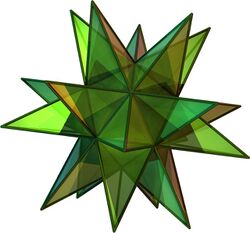 Transparent great stellated dodecahedron (Animation) |
 This polyhedron can be made as spherical tiling with a density of 7. (One spherical pentagram face is shown above, outlined in blue, filled in yellow) |
| Net | Stellation facets |
 × 20 × 20A net of a great stellated dodecahedron (surface geometry); twenty isosceles triangular pyramids, arranged like the faces of an icosahedron. |
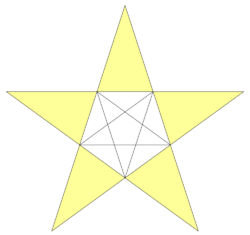 It can be constructed as the third of three stellations of the dodecahedron, and referenced as Wenninger model [W22]. |
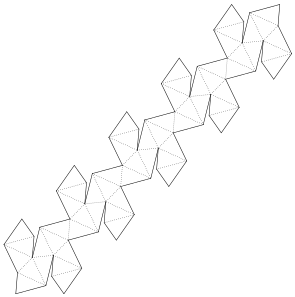 Complete net of a great stellated dodecahedron. |
Related polyhedra
A truncation process applied to the great stellated dodecahedron produces a series of uniform polyhedra. Truncating edges down to points produces the great icosidodecahedron as a rectified great stellated dodecahedron. The process completes as a birectification, reducing the original faces down to points, and producing the great icosahedron.
The truncated great stellated dodecahedron is a degenerate polyhedron, with 20 triangular faces from the truncated vertices, and 12 (hidden) pentagonal faces as truncations of the original pentagram faces, the latter forming a great dodecahedron inscribed within and sharing the edges of the icosahedron.Template:Dodecahedron stellations
| Name | Great stellated dodecahedron |
Truncated great stellated dodecahedron | Great icosidodecahedron |
Truncated great icosahedron |
Great icosahedron |
|---|---|---|---|---|---|
| Coxeter-Dynkin diagram |
|||||
| Picture | 
|
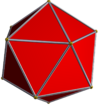
|
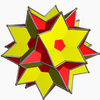
|
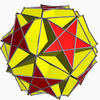
|
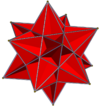
|
References
- Wenninger, Magnus (1974). Polyhedron Models. Cambridge University Press. ISBN 0-521-09859-9.
- Coxeter, Harold (1954). "Uniform Polyhedra". Philosophical Transactions of the Royal Society of London. Series A, Mathematical and Physical Sciences (Royal Society) 246 (916): 401–450. doi:10.1098/rsta.1954.0003. Bibcode: 1954RSPTA.246..401C.
External links
- Eric W. Weisstein, Great stellated dodecahedron (Uniform polyhedron) at MathWorld.
- Uniform polyhedra and duals
 |


